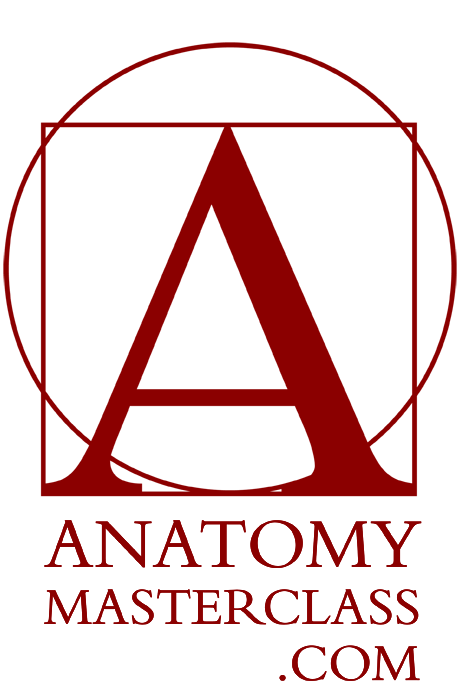Muscle Anatomy
Muscle Anatomy
Anatomy Lesson 21
In this video lesson, you will discover the muscle anatomy every proficient figurative artist must know.
Muscle Anatomy for Figurative Artists
The model for this drawing will be the marble statue of Heracles, which is displayed in the Uffizi Gallery in Florence, Italy. It is one of the most famous depictions of Heracles. Is the Roman-era marble copy from the second century A.D., modeled after the now-lost bronze original by the famous sculptor Lysippos. As a symbol of masculinity, the Heracles sculpture is an ideal model to examine well-pronounced muscles in this video lesson.
So, let’s examine the muscle anatomy by making a drawing of the Heracles sculpture.


The front portion of the neck muscle runs upwards from the top of the breastbone and inserts into the base of the skull behind the ear. The neck muscle is a very good measuring unit, which can be checked both on the model and in the drawing. The top edge of this neck muscle indicates the position of the ear.
Approximately in the middle of the collarbone, there is a small triangular gap between the deltoid and the chest muscle.
The pronounced six-pack muscle covers the abdominal part of the torso. It originates from the pubic bone and inserts into the lower part of the ribcage, at the level of the sixth and seventh ribs and the bottom end of the breastbone.
There are two curves on both sides of the torso. Just above the pelvis is the flank pad of the external oblique muscle, and right below the pelvis is the gluteus medius muscle. This curve points into the upper edge of the thighbone.
Two tailor’s muscles provide curved contours to the front of the upper legs.
It is helpful to draw an oval at the top edge of the shinbone – this defines the knee joint.
The shinbone is very close to the frontal surface of the lower leg. You can feel this bone under your fingers when you touch your leg.
The adductor group of muscles defines the outline of the upper half of the inner thigh. These muscles originate from the pelvis and run into the thighbone.
The calf muscles define the width of the lower leg. The inner portion of the calf muscle is slightly lower than the outer one.
You should also be aware that the axis of the anklebones also runs on a diagonal. The inner ankle is higher than the outer one.
The trapezium muscle defines the back side of the neck and shoulders.
The deltoid muscle originates at the outer half of the collarbone and the shoulder blade. It runs into the middle of the upper arm bone.
Two major muscles define the contours of the upper arms: the biceps brachii and the triceps brachii. The biceps occupy the front part of the upper arm, while the triceps lie over most of the rear.
Here is a very helpful rule. The height of the face, from the chin to the hairline, is three times the height of the ear.
The lower end of the ear is at the same level as the base of the nose, and the upper edge of the ear coincides with the line of the eyebrows.
The horizontal line running through the eyes divides the head in half…
[ The full lesson is avaibale to Anatomy Master Class members ]
To learn more about the muscle anatomy of a human body, enroll in the Anatomy Master Class
Simple Pricing, No Surprises
One-time payment - Only $97 USD
ENROLL NOW



